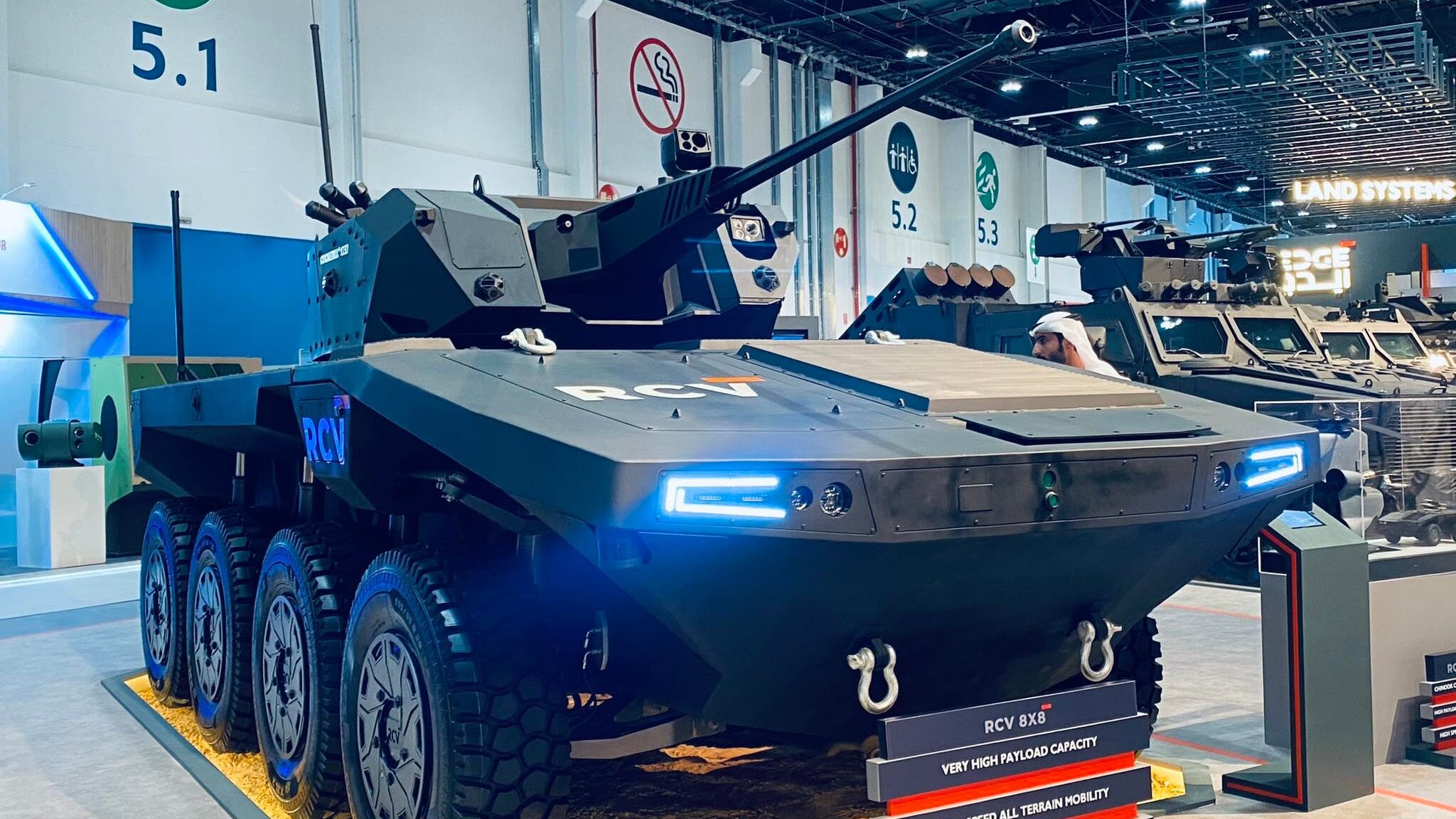
EDGE group’s RCV 8X8 design was on display at IDEX 2023. (Agnes Helou/Breaking Defense)
IDEX 2023 — It’s no surprise that the UAE’s largest defense conglomerate has the most floor space at the International Defense Exhibition (IDEX 2023), but EDGE Group also sought to make a splash with a series of announcements from day one of IDEX and its sister-show NAVDEX.
Off the bat, Abu Dhabi Ship Building, an EDGE subsidiary, inked a €1 billion ($1.07 billion) deal to provide a small fleet of new ships to the Angolan navy.
Under the agreement, Angola will purchase three BR71 MKII 71-meter corvettes, as well as assorted payloads, EDGE CEO Mansour AlMulla told Breaking Defense. Each corvette will be fitted with mission systems including a 3-D radar, an electronic warfare suite, secure communications, a main gun and surface-to-surface and surface-to-air missile systems.
Breaking Defense is reporting from the show floor of IDEX 2023. Click HERE to keep up with the latest coverage.
In its 330,000 square meter shipyard located in Abu Dhabi, ADSB builds corvettes, offshore patrol vessels and fast patrol boats for military customers, and commercial vessels for the oil services industry. It also handles maintenance and repair operations.
During a signing ceremony, David Massey, CEO of ADSB, said, “The BR71 MKII corvette is a highly advanced vessel capable of performing multiple missions to secure Angola’s 1,600 kilometer coastline. We look forward to fulfilling the Angolan Navy’s operational requirements and strengthening their naval capabilities while expanding ADSB’s avenues of growth.”
RELATED: EDGE Group CEO talks acquisitions, Chinese and Russian cooperation and autonomous systems
The conglomerate also used day one of the show to unveil 11 new autonomous weapons systems, with a mix of land, sea and air designs.
Among those designs is the Jeniah, an autonomous aerial vehicle. The drone, as designed, would have a 1,000 kilometer per hour speed and is designed to be a low observable platform. Not much else was revealed about the aircraft, and AlMulla told Breaking Defense that Jeniah is still a project in early development.
“This is a new version of [a] UCAV for surveillance and attack missions. It is a jet engine drone and can carry a payload of up to 500 kilograms,” AlMulla said. Most importantly, he stressed, “It’s only designed and developed and built by EDGE, a UAE [intellectual property], with no international partner.”
AlMulla expects the drone to be ready in four years but said that EDGE is looking at ways to accelerate the development and production phase, including investing in foreign firms to bring new technology for the design.
A second aerial unmanned system the company rolled out is the Airtruck, which it bills as having a paylod of 500 kilograms and a maximum range of 360 kilometers at a cruising speed of 120 kilometers per hour. The system is designed for strategic logistics support such as supplying troops in remote locations, medical evacuation, and reconnaissance.
Another logistics transport drone unveiled by the firm is the QX6-50, developed for both military and civilian applications. Capable of carrying a 50 kilograms payload for up to 200 kilometers, the rotary-wing unmanned aerial vehicle can operate autonomously and should be able to integrate into existing QX variants.
Interestingly, one of the designs on display, the Instrumented Testing Platform, is a fixed-wing UAV that is designed for in-house flight testing of air-to-surface munitions, presumably also available for export.
The backend of unmanned systems also was showcased, with EDGE showing off two unmanned traffic management (UTM) solutions, the result of a $14 million strategic investment in UTM startup High Lander. The Universal UTM offering claims “real-time, autonomous monitoring of flight plans and drone activity, with the capability to approve or deny flights, suggest alternative routes, and react to mid-flight changes.” The company also showed off its interactive Mission Control Platform, which allows users to automate and control a drone fleet in real-time.
On the naval side, the Emirati conglomerate unveiled ADSB’s 170 Detector USV, designed for maritime ISR and underwater mine detection missions. The company says the design can be configured for manned or unmanned operations, and can be used for either military or civilian purposes.
Turning to ground vehicles, EDGE showed off the results of its recent investment in Estonian firm MilRem, with the Type X Robotic Combat Vehicle (RCV). The company bills it as “rapidly deployable alongside traditional infantry fighting vehicles (IFVs) to provide overmatching firepower and tactical usage on the battlefield.” EDGE also rolled out an 8×8 Robotic Combat Vehicle concept, NIMR RCV, billed as a modular, multi-role platform.
“The vehicle is highly customizable of modular design,” Nimr CEO Abri Du Plessis told Breaking Defense. He noted that the “top center part of the vehicle can be removed and replaced by another module like weapons system, missile launchers, anti-drone solutions or others,” and the biggest feature is the extremely high payload up to 12 tons held up by eight wheels and the four axels.





















